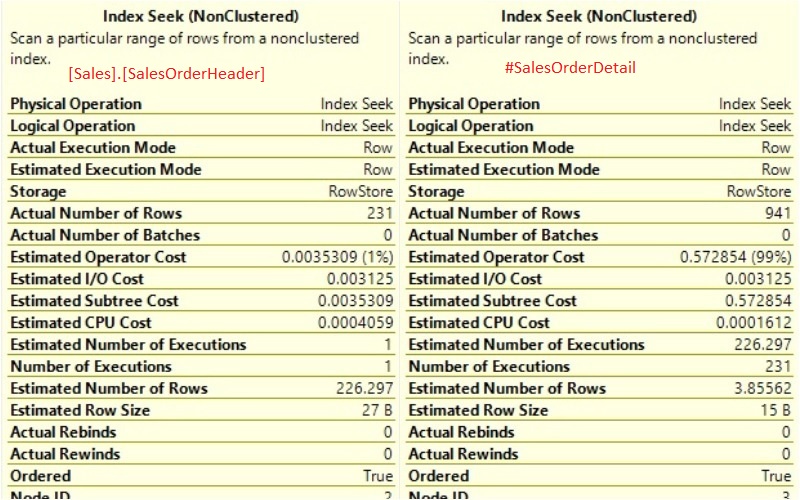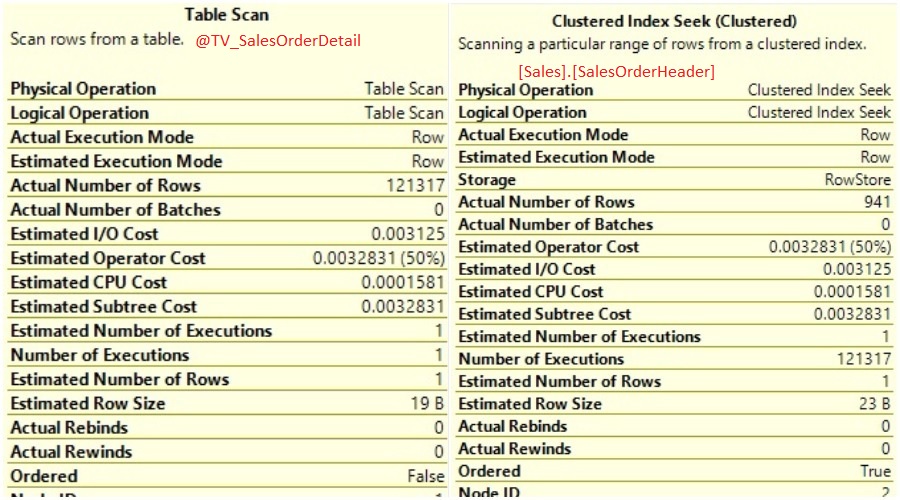Hi Friends,
In my previous blog post, I have shown you the working of nested loop join in SQL Server. Today, I am going to show you the Nested Loop Join – Temp Table versus Table variable.
Before executing a query, SQL Server generates an estimated execution plan on the basis of various server settings and then uses that plan for actual execution of the query.
Nested Loop Join with Temp Table:
Here, I am using AdventureWorks2014 database. In my previous post, I have shown that during nested loop join SQL Server uses one input as outer and other as inner. Generally, out input will be the input, which has less number of rows.
In the below queries, I am creating a temp table and populating it with the data from [Sales].[SalesOrderDetail] table. Next, I am executing a query which has a join condition:
Select * INTO #SalesOrderDetail from [Sales].[SalesOrderDetail] GO CREATE NONCLUSTERED INDEX NC1_Temp_SalesOrderDetail ON [dbo].[#SalesOrderDetail] ([SalesOrderID]) INCLUDE ([UnitPrice]) GO SET STATISTICS TIME ON Select SOD.UnitPrice, SOH.DueDate, SOH.OrderDate from #SalesOrderDetail SOD join [Sales].[SalesOrderHeader] SOH on sod.SalesOrderID=SOH.SalesOrderID Where SOH.OrderDate between '2011-07-01' AND '2011-07-31' GO

In the above query plan, you can see that SQL Server decides to use the temp table as an inner input. Now the question is why it is selected as inner input, why not selected as outer input? The answer is based on the statistics, SQL Server knows that temp table has more number of rows as compared to [Sales].[SalesOrderHeader]. So, for nested loop join this temp table has been selected as inner input. You can see the number of rows from the operator properties:

Nested Loop Join with Temp Table:
Now let me try to replace the temp table with table variable and see the impact.
Declare @TV_SalesOrderDetail Table
(
[SalesOrderID] [int] NOT NULL,
[SalesOrderDetailID] [int] NOT NULL,
[CarrierTrackingNumber] [nvarchar](25) NULL,
[OrderQty] [smallint] NOT NULL,
[ProductID] [int] NOT NULL,
[SpecialOfferID] [int] NOT NULL,
[UnitPrice] [money] NOT NULL,
[UnitPriceDiscount] [money] NOT NULL,
[LineTotal] [money],
[rowguid] [uniqueidentifier] ROWGUIDCOL,
[ModifiedDate] [datetime] NOT NULL
)
INSERT INTO @TV_SalesOrderDetail
SELECT [SalesOrderID]
,[SalesOrderDetailID]
,[CarrierTrackingNumber]
,[OrderQty]
,[ProductID]
,[SpecialOfferID]
,[UnitPrice]
,[UnitPriceDiscount]
,[LineTotal]
,[rowguid]
,[ModifiedDate]
FROM [Sales].[SalesOrderDetail]
SET STATISTICS TIME ON
Select SOD.UnitPrice,
SOH.DueDate, SOH.OrderDate
from @TV_SalesOrderDetail SOD
join [Sales].[SalesOrderHeader] SOH
on sod.SalesOrderID=SOH.SalesOrderID
Where SOH.OrderDate between '2011-07-01' AND '2011-07-31'
GO

From the above plan, you can see, this time SQL Server selected the table variable as an outer input while it is having more number of rows as compared to another input table i.e. [Sales].[SalesOrderHeader]. You can see this in the operator properties:

Actually, the reason behind the selection of the table variable as an outer input is the difference between Actual and Estimated number of rows and you can compare these values in the above operator properties image.
So, if you are using table variables in the join queries, then keep in mind that selection of an operator depends on the estimated number of rows not on the actual number of rows. If there is a situation, where you know that your table variable will contain more than 100 rows, then it’s always better to use temp table instead of using table variable.
Is there any impact on my execution time due to the table variable? Yes, you can compare the execution time for both from the below time statistics.
For the above temp table query SQL Server Execution Times: CPU time = 16 ms, elapsed time = 100 ms. SQL Server parse and compile time: CPU time = 0 ms, elapsed time = 0 ms. SQL Server Execution Times: CPU time = 0 ms, elapsed time = 0 ms. For the above table variable query SQL Server Execution Times: CPU time = 188 ms, elapsed time = 331 ms. SQL Server parse and compile time: CPU time = 0 ms, elapsed time = 0 ms. SQL Server Execution Times: CPU time = 0 ms, elapsed time = 0 ms.
HAPPY LEARNING!
Regards:
Prince Kumar Rastogi
Like us on FaceBook | Join the fastest growing SQL Server group on FaceBook
Follow Prince Rastogi on Twitter | Follow Prince Rastogi on FaceBook
